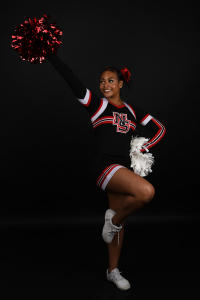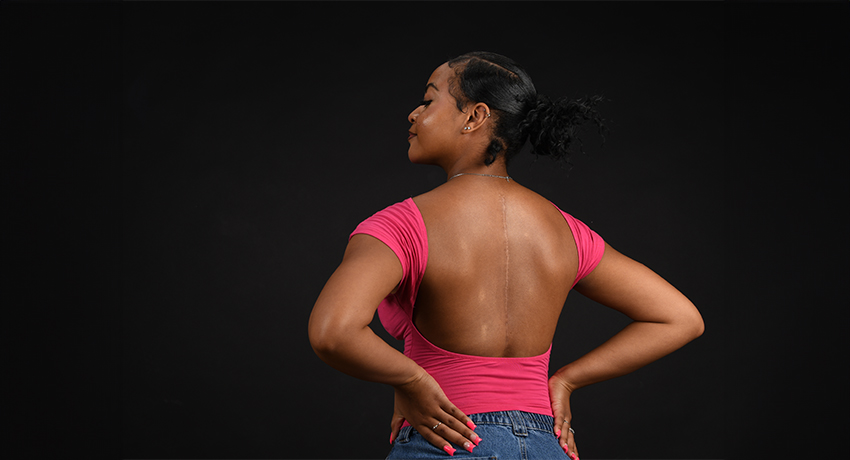Kylah Eckford, 16, is an outgoing teenager with a passion for cheerleading.
“I get so much joy from cheer,” she said.
She first discovered her connection to the sport in the seventh grade.
“I love cheering because of the fun energy it brings,” said Kylah. “I take pride in performing for others and being the face of school spirit.”
And it was this very sport that ultimately helped uncover a severe, quietly developing spine condition.
Sports physical intervention
In March 2021, while Kylah was undergoing a sports physical for eighth-grade cheer tryouts, a nurse noticed a problem.
“She told me to stand up and bend over,” said Kylah. “As she was looking at my back, she said, ‘I can’t clear you.’”
The clinic nurse saw signs of potential scoliosis.
Kylah underwent X-rays and was allowed to try out for the team while waiting for the results.
“At 5 o’clock that day, I got the call that she made the team, but just 30 minutes later, her primary care doctor called with the X-ray results,” said Franshell Eckford, Kylah’s mother. “The doctor said, ‘I can’t clear her. I’m recommending she see a surgeon for her spine.’”
Adolescent idiopathic scoliosis

Kylah was referred to Shiraz A. Younas, MD, a pediatric orthopedic surgeon and scoliosis specialist with UT Physicians.
After a second round of X-rays, she was diagnosed with adolescent idiopathic scoliosis, which impacts about 2% of the adolescent population in the U.S.
The condition is a three-dimensional deformity of the spine. This includes an S- or C-shaped curve when looking at the back from behind, rotation of the spine that elevates the ribs on one side, and usually a flattening out of the spine when looking at it from the side.
“It is similar to the concept of ringing out a towel. It is that type of rotation where the upper part of the spine rotates in one direction and the bottom part rotates in the opposite direction,” explained Younas, an associate professor in the Department of Orthopedic Surgery with McGovern Medical School at UTHealth Houston.
Few to no symptoms
“It is usually asymptomatic, develops in adolescence, and for a lot of our patients like Kylah, comes as a surprise,” said Younas.
Kylah noticed she had slightly uneven shoulders and one shoulder blade protruded while the other remained flat, but she never experienced pain.
“We know now that she had a deep curve, but she had no back pain,” said Franshell. “Nothing was bothering her at all.”
No known cause
“We don’t know what causes scoliosis,” said Younas.
There are cases where several family members share the same diagnosis, but he says it doesn’t explain cases like Kylah’s with no clear inheritance link.
“There’s no clear hereditary pattern, but we do see it cluster in families,” said Younas. “And even then, one family member may need surgery while another doesn’t. So, the severity of it doesn’t always match up.”
Scoliosis surgery

While not every scoliosis patient needs surgery, Younas recommended it for Kylah.
“Hers was at a point where it was projected to progress into adulthood,” said Younas. “Without surgery, it would become a severe adult deformity.”
Younas worked with Kylah to keep her on the cheer squad and scheduled her surgery during a lull in her eighth-grade season so she would have time to recover from surgery.
“I was able to cheer for the football season,” said Kylah.
In November 2021, she underwent a successful scoliosis surgery. Younas inserted two metal rods, one on each side of her spine, from her shoulder blades down to her mid-back. The rods were attached to her spine with 18 screws.
“We gradually pull the spine to those rods and correct all three planes of deformity at the same time,” said Younas. “The rods and screws act as a scaffold while the spine heals in the new corrected and balanced position.”
Kylah was closely watched by an anesthesia team and a neuromonitoring team through each procedure step.
The surgery lasted approximately five hours. For Kylah, it was a seven- to eight-hour process, including prep and waking up from anesthesia.
Scoliosis recovery

Scoliosis surgery patients stay in the hospital for several days of monitoring. The day after surgery, Kylah began moving using a walker.
“There was tension in my back. It felt like sharp needles, and I had shortness of breath,” said Kylah. “But I knew I needed to try.”
“It’s sort of like biking up a hill; it’s tough that first day to muster the energy and courage to get up and stand, but once you do that, you’re at the top of the hill,” said Younas. “It gets easier.”
After three days in the hospital, Kylah was discharged with a walker to use and strict limitations on twisting, lifting, and bending. She couldn’t turn her neck.
“In the beginning, even brushing my teeth hurt my back,” said Kylah.
At-home scoliosis recovery
With limited mobility, her in-home scoliosis recovery relied heavily on family members.
“We do a lot of coaching ahead of time. We tell patients and their families that surgery is just 50% of the job. The other 50% is on the family members to encourage patients through recovery,” said Younas.
For the first month, Kylah was homebound, which took an emotional toll on a social teen.
“It was almost depressing for me because I went from walking whenever I wanted to sitting in a chair most of the day. For a while, it felt like it wasn’t going to get better,” explained Kylah.
A steady routine of standing and walking for 15 minutes every hour slowly rebuilt her core, and she regained strength.
The turning point in her scoliosis recovery came several weeks later when she was able to step out of the house. With the assistance of a walker, she made it halfway down her street and back.
“As simple as it sounds, it was a big milestone for me,” said Kylah. “I was finally able to see my progression.”
By Christmas, she was walking on her own, and by mid-January, she was back at school, though still restricted on lifting, bending, and twisting.
Back to cheer

Kylah sat out her spring semester on the eighth-grade cheer team but was approved to try out for the ninth-grade team, though with limitations.
She beat out dozens of contenders to make the 12-member North Shore Senior High School freshman squad and became captain.
“I was really proud of myself and everything I went through,” said Kylah. “Being on the field under the football lights one year after surgery was such a happy feeling.”
She made the varsity squad during her sophomore year, and now, going into her junior year, she will be co-captain.
“It is very rewarding to see her back in action doing what she loves,” said Franshell. “If it wasn’t for cheer and the sports physical, we may not have found this diagnosis this early.”
One day, when Kylah Eckford looks back at her adolescence, what she’ll remember most is cheerleading, the diagnosis that resulted, and the doctor who saved her back.
“Dr. Younas is a great doctor. He took good care of me, and he’s why I’m here today,” said Kylah. “My life was in his hands.”



